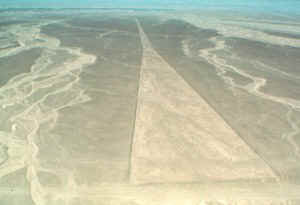

Destinations
Experiences
 |
L A
D A T C O T O U R
S |
 |
||||||||
| HOME | South America | Falkland Islands | Antarctica | Unique Destinations |
Unique Experiences |
Newsstand | ||||
|
Nazca One of the World's great
mysteries
Partial
map of the Lines |
 |
South of Lima some 472 km lie the mysterious Plains of Nazca. Situated in the arid desert lands near the city of Nazca, the Plains take their name from the highly developed civilization of the Nazcas which flourished in this area around 800 A.D.
Rediscovered by Paul Kosok in 1929, the Plains have been studied by many archaeologists but it was Maria Reiche, German mathematician who first brought wide spread notice to the Plains when she moved there in 1932 to live in a one room bungalow next to the major drawings. Since then she has dedicated her life to the mysterious lines and figures that spread some 32 miles along the desert.
Situated in one of the driest deserts of the world, the conditions are perfect for preservation of the lines which were made by the removal of darker stones from the lighter colored earth. As they were removed. the stones were stacked up in piles along the perimeter, thus adding more depth and outline to the lines which average a few inches deep and never more than a foot in depth.
The lines include straight lines ranging from 1 to 10 feet in width and 4 to 5 miles in length and which generally originate from and connect centers of trapezoidal or triangular lines.
There are also geometric and representational figures, always formed by one continuous line, as if drawn by someone unable to lift his pen from the drawing surface. Among the figures are a crocodile or lizard over 600 feet long, a bird with a snake like neck, a spider over 150 feet long, a fish some 80 feet long and many other figures.
Theories surrounding the origin of these lines and figures are many - including Von Daniken’s (author of Chariot of the Gods) famous theory that they were used as guidings and landing strips for ancient astronauts. Other theories include irrigation and astronomical measures. One line points directly to the December 21 summer solstice in the Southern Hemisphere for the setting sun some 1000 years ago.
ABOUT THE LINES - By PromPeru:
Just two hours from Ica, 50 square km of desert floor were covered centuries ago by vast drawings, figures of mammals, insects and deities. The Nazca Lines, discovered in 1927, are the most extraordinary legacy left by a culture that flourished in 300 BC. The lines are a series of complex designs, some up to 300 meters long which can only be seen in their true dimension from the sky, from an altitude of at least 1,500 feet. The Nazca culture is not believed to have been capable of manned flight. But the question remains as to how they crafted the drawings, what technology they used and what purpose the lines served.
Theories abound regarding these mysterious etchings, ranging from landing strips for aliens to a giant seismograph. The most probable theory is that of Marķa Reiche, a German researcher who dedicated her life to studying the lines. Ms Reiche believed that the lines were part of a vast astronomic calendar whose figures marked different solar phases. Ms Reiche, affectionately nicknamed the Angel of the Plains by the local inhabitants, was the first to discover the ancient technique of digging into the tough and dry desert floor and covering the track with stones brought from distant sites. The component of natural plaster existing in the area helped to preserve for thousands of years the drawings: the hummingbird, the spider, the condor and the monkey, among the more than 30 figures etched into the plain.
The Nazca Plains (there are four areas in total: Palpa, Ingenio, Nazca and Socos) lie in the department of Ica, some 460 km south of Lima. Like an embroidery of the gods, the lines that decorate the desert floor have been declared a Mankind Heritage Site by UNESCO, and the ancient mystery of the figures still waits to be unraveled.